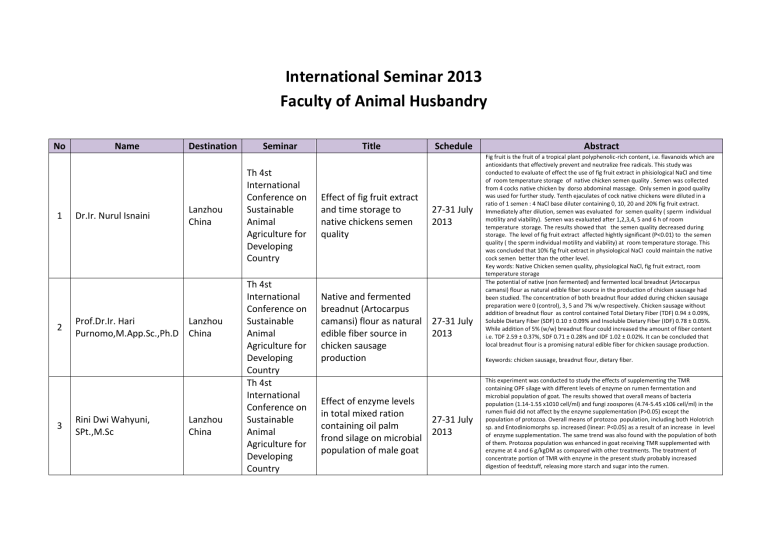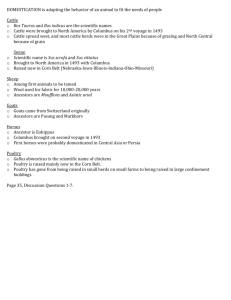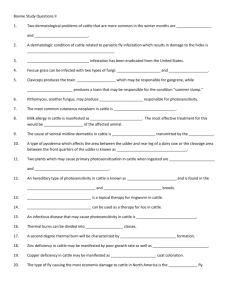International Seminar 2013 Faculty of Animal Husbandry

International Seminar 2013
Faculty of Animal Husbandry
No
1
2
3
Rini Dwi Wahyuni,
SPt.,M.Sc
Name
Dr.Ir. Nurul Isnaini
Prof.Dr.Ir. Hari
Purnomo,M.App.Sc.,Ph.D
Destination
Lanzhou
China
Lanzhou
China
Lanzhou
China
Seminar
Th 4st
International
Conference on
Sustainable
Animal
Agriculture for
Developing
Country
Th 4st
International
Conference on
Sustainable
Animal
Agriculture for
Developing
Country
Th 4st
International
Conference on
Sustainable
Animal
Agriculture for
Developing
Country
Effect of fig fruit extract and time storage to native chickens semen quality
Title
Native and fermented breadnut (Artocarpus camansi) flour as natural edible fiber source in chicken sausage production
Schedule
27-31 July
2013
27-31 July
2013
Abstract
Fig fruit is the fruit of a tropical plant polyphenolic-rich content, i.e. flavanoids which are antioxidants that effectively prevent and neutralize free radicals. This study was conducted to evaluate of effect the use of fig fruit extract in phisiological NaCl and time of room temperature storage of native chicken semen quality . Semen was collected from 4 cocks native chicken by dorso abdominal massage. Only semen in good quality was used for further study. Tenth ejaculates of cock native chickens were diluted in a ratio of 1 semen : 4 NaCl base diluter containing 0, 10, 20 and 20% fig fruit extract.
Immediately after dilution, semen was evaluated for semen quality ( sperm individual motility and viability). Semen was evaluated after 1,2,3,4, 5 and 6 h of room temperature storage. The results showed that the semen quality decreased during storage. The level of fig fruit extract affected hightly significant (P<0.01) to the semen quality ( the sperm individual motility and viability) at room temperature storage. This was concluded that 10% fig fruit extract in physiological NaCl could maintain the native cock semen better than the other level.
Key words: Native Chicken semen quality, physiological NaCl, fig fruit extract, room temperature storage
The potential of native (non fermented) and fermented local breadnut (Artocarpus camansi) flour as natural edible fiber source in the production of chicken sausage had been studied. The concentration of both breadnut flour added during chicken sausage preparation were 0 (control), 3, 5 and 7% w/w respectively. Chicken sausage without addition of breadnut flour as control contained Total Dietary Fiber (TDF) 0.94 ± 0.09%,
Soluble Dietary Fiber (SDF) 0.10 ± 0.09% and Insoluble Dietary Fiber (IDF) 0.78 ± 0.05%.
While addition of 5% (w/w) breadnut flour could increased the amount of fiber content i.e. TDF 2.59 ± 0.37%, SDF 0.71 ± 0.28% and IDF 1.02 ± 0.02%. It can be concluded that local breadnut flour is a promising natural edible fiber for chicken sausage production.
Keywords: chicken sausage, breadnut flour, dietary fiber.
Effect of enzyme levels in total mixed ration containing oil palm frond silage on microbial population of male goat
27-31 July
2013
This experiment was conducted to study the effects of supplementing the TMR containing OPF silage with different levels of enzyme on rumen fermentation and microbial population of goat. The results showed that overall means of bacteria population (1.14-1.55 x1010 cell/ml) and fungi zoospores (4.74-5.45 x106 cell/ml) in the rumen fluid did not affect by the enzyme supplementation (P>0.05) except the population of protozoa. Overall means of protozoa population, including both Holotrich sp. and Entodiniomorphs sp. increased (linear: P<0.05) as a result of an increase in level of enzyme supplementation. The same trend was also found with the population of both of them. Protozoa population was enhanced in goat receiving TMR supplemented with enzyme at 4 and 6 g/kgDM as compared with other treatments. The treatment of concentrate portion of TMR with enzyme in the present study probably increased digestion of feedstuff, releasing more starch and sugar into the rumen.
Keywords: enzyme, total mixed ration, oil palm frond, silage, microbial population, goat
4
6
Eko Nugroho,SPt.,M.Sc
5 Herly Evanuarini,SPt.,MP
Ir. Hari Dwi
Utami,M.Appl.Sc.,Ph.D
Lanzhou
China
Lanzhou
China
Budapest
Hungary
Th 4st
International
Conference on
Sustainable
Animal
Agriculture for
Developing
Country
The 4th
International
Conference on
Sustainable
Animal
Agriculture for
Developing
Country
International
Food
Marketing
Research
Symposium
The sociao economic potential of Indonesian native cattle: study on smallholder rambon cattle farming in East
Java
The effect of corn oil addition on physical and organoleptic properties of mayonnaise
The Insight towards pattern of beef cattle marketing systems at
East Java, Indonesia
27-31 July
2013
27-31 July
2013
20-21
June 2013
The cattle population in Indonesia remains far from sufficient to fulfill the national demand for meat. To cope with this problem, the government allows and increases the amount of imported life cattle and frozen meat. At the same time, Indonesia pursues self-sufficiency for meat by 2014, by increasing the local production with local breeds.
Rambon cattle – originating from the regency Banyuwangi in East Java - is one of
Indonesia’s native cattle breeds with potentials that not yet have been fully explored.
This study reveals the socio-economic impact of the Rambon cattle and the indigenous knowledge of the farmers in the village Kemiren. Sixty-five farmers were selected and interviewed using a questionnaire. The data was analyzed with a descriptive analysis. The study shows that on average a famer owned 1.29 ± 0.80 heads Rambon cattle. The farmers with Rambon cattle are at a productive age (between 15 and 64 years old), and less educated but experienced farmers (16.20 years of farming ± 10.00 years). The available family labor is relatively high with 3.53 ± 0.87 Adult Worker Equivalent. Their farm size varied widely, namely rice fields 0.31 ± 0.23 ha, dry land 0.061 ± 0.13 ha, and home gardens 0.045 ± 0.055 ha respectively. Most farmers attended their own cattle, instead of profit sharing with a shepherd. Moreover, Rambon cattle is mainly held as a draught animal to cultivate the land.
Rambon cattle farmers earn yearly on average USD 188 per animal in addition to their use as a ploughing animal. Besides, farmers generate an income by farming, trading, or as a civil servant. The additional income of USD 188 is the result of selling the animal at the market after two years of fattening. This shows that with the contemporary but traditional management, Rambon cattle are socio-economic important to a farmer’s household.
Key words: Rambon cattle, economic value, Indonesia, smallholder farmers
Mayonnaise is a kind of semi-solid oil-in-water emulsion. Vegetable oils have an important function in an emulsion to contribute to the texture, the appearance and the organoleptic properties of mayonnaise. The aim of this study was to observe the optimal concentration of corn oil on physical quality and organoleptik properties of mayonnaise.
Mayonnaise samples contained 75% oil with different proportion of corn oil and soya oil.
The parameter measured were pH, viscosity, and sensory evaluation scores of taste, flavor, colour. The result showed that the addition of corn oil affects the physical and organoleptik properties of mayonnaise.
Keywords : corn oil, soya oil, mayonnaise
The study was executed at Regency of Bojonegoro, East Java Province, Indonesia. The purpose of the study was to investigate the pattern in marketing system of beef cattle and to examine marketing margin, percentage margin, and mark up price, profit margin, and marketing efficiency along the marketing channel. 30 cattle traders were obtained using purposive sampling methods based on the beef cattle sold during a month. Primary and secondary data were collected during one month from 1st October to 31st October
2012. These data were gathered by enumerators with implementing structure questionnaire. Descriptive analysis involving marketing margin, percentage margin, and mark up price, profit margin, and marketing efficiency were applied to analyze the data.
Results showed that there were two systems in marketing beef cattle namely, direct
7
8
Achadiah
Rachmawati,SPt.,M.Si
Firman Jaya, SPt.,MP
9 Prof.Dr.Ir. Kusmartono
Lanzhou
China
Lanzhou
China
Sapporo
Jepang
Th 4st
International
Conference on
Sustainable
Animal
Agriculture for
Developing
Country
Th 4st
International
Conference on
Sustainable
Animal
Agriculture for
Developing
Country
The Capacitation status of Ram Ettawa
Crossbreed's sperms by
α-tocopherol supplementation in extender during cooling
Natural antioxidant properties of functional drink prepared by combination of local honey and red ginger extract
IDF World Bairy
Summit 2013
Nutritional status of lactating dairy cows raised under smallholder farmers at different altitude in East
Java, Indonesia
27-31 July
2013
27-31 July
2013
30
November
- 5
Desember
2013 marketing (27%) and indirect marketing (73%) systems. Indirect marketing system has comprised of four Marketing Pattern (MP) namely, (i) MP- I was operated between villages in one Sub-District, (ii) MP- II was carried out between Sub-districts in one
Regency, (iii) MP- III was held between District in one Province, and (iv) MP- IV was executed between Provinces (national wide marketing). The marketing margin in both calf and mature cattle have varied along the four marketing patterns with the lowest (Rp.
37, 632,-, vs. Rp. 71, 589,-) on MP-II and the highest (Rp. 1, 672, 448, - vs. Rp.3, 181,
571,-) on MP-IV, respectively. The increase price for the four marketing patterns in order was 6.18%, 0.64%, 10.15%, and 20.42%. Beef cattle marketing system was inefficient based on the following criteria: Rp. 6,657,290, - of price spread, 74.30% of mark-up price,
121.92% of percentage margin and 0.61% of marketing efficiency.
Keywords: Beef Cattle Marketing System, Marketing Margin, Price Spread, Mark-up Price,
Marketing Efficiency
10 Prof.Dr.Ir. Suyadi,MS
11
12 Dr. Ir. Marjuki,M.Sc
13
Dr.Ir. V.M. Ani
Nurgiantiningsih,M.Sc
Dr.Ir. Sri
Wahyuningsih,M.Si
Beijing Cina
The 11st World
Conference on
Animal
Production
Beijing Cina
The 11st World
Conference on
Animal
Production
Beijing Cina
Beijing Cina
The 11st World
Conference on
Animal
Production
The 11st World
Conference on
Animal
Production
14 Dr.Ir. Gatot Ciptadi,DESS Beijing Cina
The 11st World
Conference on
Animal
Production
15 Dr.Ir.Eko Widodo, M.Sc
Hanoi
Vietnam
The 5th World
Waterfowl
Conference
Accuracy of pregnancy diagnosis by ultrasohographic technique in peranakan ettawa does following natural mating or artificial insemination
Breeding potency of fillal ongole cattle as local Indonesian breed in city of Probolinggo
East Java, Indonesia
Variability of crude protein content of fishmeal used in animal diets in East Java,
Indonesia
In vitro maturation rate of local goat oocytes from different follicular size
The importance of kariotyping for early investigation on genetic abnormalities in cattle and buffalo sires used for artificial insemination
Betaine improves hydrid duck production performances when fed low methionine diet
15-20
Oktober
2013
15-20
Oktober
2013
15-20
Oktober
2013
15-20
Oktober
2013
15-20
Oktober
2013
6-8
Nopember
2013
16
Dr. Ir. Irfan H. Djunaidi,
M.Sc
Hanoi
Vietnam
The 5th World
Waterfowl
Conference
Inclusion effect of
Mangosteen (Garcinia
Mangostant.L) peel meal as feed additive on egg fertility of Mojosari duck
6-8
Nopember
2013







